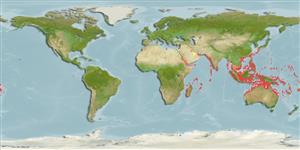Environment: milieu / climate zone / depth range / distribution range
Ecología
marino asociado a arrecife; rango de profundidad 10 - 45 m (Ref. 90102), usually 20 - 42 m (Ref. 9710). Tropical; 23°C - 28°C (Ref. 27115)
Distribución
Países | Áreas FAO | Ecosistemas | Ocurrencias, apariciones | Point map | Introducciones | Faunafri
Indo-West Pacific: Red Sea south to Natal, South Africa (Ref. 4392) and east to Bali, Indonesia.
Tamaño / Peso / Age
Maturity: Lm ? range ? - ? cm
Max length : 13.0 cm TL macho / no sexado; (Ref. 11441)
Espinas dorsales (total): 9; Radios blandos dorsales (total): 12; Espinas anales 3; Radios blandos anales: 12. Body orange-brown, with pale longitudinal blue-green lines following scale rows; head with irregular light blue-green lines; opercular flap with a black spot; caudal fin white with a broad black bar on posterior part of fin (Ref. 4392). Red Sea form is slightly different. Females are distinguished by the white versus yellow band on the base of the tail and males by the lined versus spotted pattern on the body (Ref. 48636).
Adults inhabit lagoon and seaward reefs, usually deeper than 20 m to at least 42 m (Ref. 9710). Juveniles are solitary and adults form small groups, each with several females and a dominant male (Ref. 48636). Oviparous, distinct pairing during breeding (Ref. 205). Minimum depth reported from Ref. 27115.
Life cycle and mating behavior
Madurez | Reproducción | Puesta | Huevos | Fecundidad | Larva
Oviparous, distinct pairing during breeding (Ref. 205).
Randall, J.E., 1986. Labridae. p. 683-706. In M.M. Smith and P.C. Heemstra (eds.) Smiths' sea fishes. Springer-Verlag, Berlin. (Ref. 4392)
IUCN Red List Status (Ref. 130435)
Threat to humans
Harmless
Human uses
Acuario: Comercial
Más información
ReferenciasAcuiculturaPerfil de acuiculturaRazasGenéticaElectrophoresesheritabilidadEnfermedadesProcesamientoNutrientsMass conversion
ColaboradoresImágenesStamps, Coins Misc.SonidosCiguateraVelocidadTipo de nataciónSuperficie branquialOtolitosCerebrosVisión
Herramientas
Special reports
Download XML
Fuentes de Internet
Estimates based on models
Preferred temperature (Ref.
123201): 24.5 - 29, mean 28 °C (based on 1028 cells).
Phylogenetic diversity index (Ref.
82804): PD
50 = 0.5002 [Uniqueness, from 0.5 = low to 2.0 = high].
Bayesian length-weight: a=0.00977 (0.00470 - 0.02030), b=3.07 (2.89 - 3.25), in cm total length, based on LWR estimates for this (Sub)family-body shape (Ref.
93245).
Nivel trófico (Ref.
69278): 3.4 ±0.4 se; based on size and trophs of closest relatives
Resiliencia (Ref.
120179): Alto, población duplicada en un tiempo mínimo inferior a 15 meses (Preliminary K or Fecundity.).
Fishing Vulnerability (Ref.
59153): Low vulnerability (10 of 100).
Nutrients (Ref.
124155): Calcium = 92.3 [55.5, 161.8] mg/100g; Iron = 0.75 [0.44, 1.38] mg/100g; Protein = 18.5 [15.6, 20.7] %; Omega3 = 0.172 [0.108, 0.276] g/100g; Selenium = 24.7 [14.4, 44.9] μg/100g; VitaminA = 153 [47, 579] μg/100g; Zinc = 1.71 [1.16, 2.66] mg/100g (wet weight);
